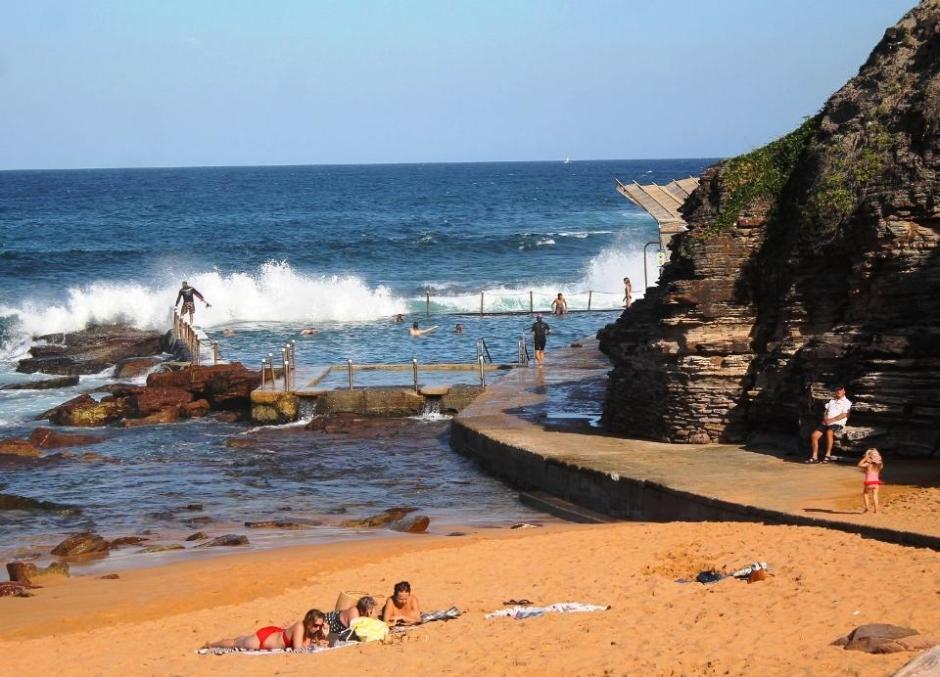April 3 - 9, 2016: Issue 258
Liz Muir
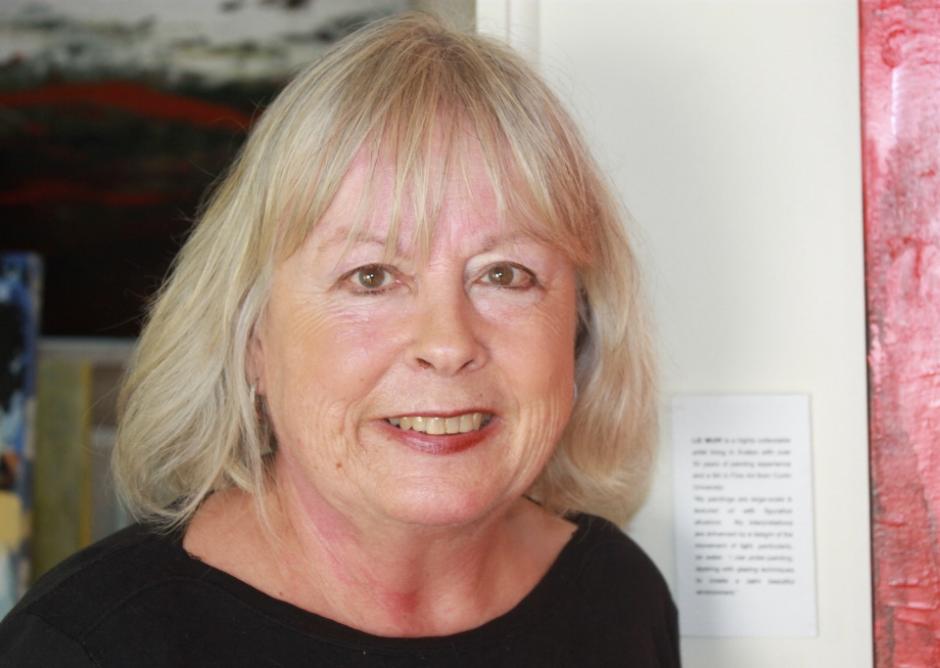
Vibrancy informed by a lifetime of looking beyond the surface marks Liz Muir's approach to her art and to her life. Leaving a career as a successful business woman who once ran her own company with her partner, Keren, Liz returned to her first love - expressing through colour and layers of colour, what lives within through painting.
A mature aged student, this lady fought for and succeeded in securing a BA in Fine Arts while battling the scourge of many generations of Australians - cancer. Her determination continues and persists, she wakes before dawn and plans her day, determined to make every moment count, to fill every minute with living.
Soft spoken but filled with energy, this Avalon artist prefers the backtracks where you may see sun glint on water, sense the tendrils of a breeze through mangrove leaves, and then the bright open skies and the dappling of reflections in a rock pool - and what is informing the surface by seeing beyond it there too.
Our April 2016 Artist of the Month is a wonderful lady who strives to 'push it to the limit' - each and everyday:
Where were you born and where did you grow up?
In Sydney, 1950. We moved everywhere. We went to Melbourne because my father was with ASIO and then the Australian Federal Police. We then went to Italy and he was involved in scrutineering all of the immigrants who were coming in, Italians and Greeks, who were wonderful for the country.
We lived there for three years and that started my love of Art because we played in villas, in Venice, in broken down streets, the Colosseum and Pompeii. The beauty of it really struck me and embedded in my mind the old and the damaged has many layers. There was gold and then this was broken and underneath would be another colour – this was our playground.
Some of my earliest memories are of Venice, of coming up in a little boat when it was all grey and wet and rainy and then these amazing buildings appear in front of my eyes out of the mist. As a tiny little person this was just staggering.
We lived in a huge apartment in a suburb called EUR, which was for expatriates. We’d leave the house at nine in the morning and return at five and play around all these half-built buildings. These had been constructed for Mussolini and they started and then stopped as they ran out of money (EUR was the projected site for a world exhibition slated for 1942 to be a showcase of his Fascist-preferred architecture). They finished these around 1960 – so there were half-built statues, half built buildings, it was amazing. They were tidying these up for the Rome Olympics when we arrived there, the marble was already down and we used to roller skate around statues of David – if that isn’t going to impress you and stay in your mind, I’m not sure what will.
We then spent a lot of time travelling around Europe prior to going to England. At each destination I was placed in a different school and in Italy it was a school called ‘Marymount’ which was run by nuns. They didn’t bother very much with English – that was wonderful, they were very kind.
We then came back to Australia by ship, a glorious experience.
What ship did you travel on?
We went over on the Oriana and came back on the Orchedes. They had huge massive staircases going up; the libraries were just beautiful, the restaurants, the paintings and the decorations were just so amazing. We had a children’s room, and were the only ones ever in it. We had the whole boat to riot around.
Where did you settle when you returned to Australia?
We settled in Lindfield. I went to Lindfield Public School, then moved to Abbotsleigh. I left school at what was then the Intermediate Certificate, doing a secretarial course then worked various secretarial/accounting positions before becoming an air hostess for QANTAS on the Singapore to London run.
Were you painting when you were in your 20’s?
On leaving Qantas I began painting in earnest in a traditional manner. I sold my first painting at 26– a large painting of Narrabeen Lake, which had weeds in the foreground and the lake behind these. It was a gorgeous painting.
Have you done any training to help you?
Yes. I studied with Brian Agnew, an oil painter for two years. After a several years I started working in watercolours, which is really important to the education for an Artist as watercolours are difficult to master. Helen Goldsmith, a wonderful water-colourist, was my teacher. I applied to Curtin University in WA and started a BA in Fine Art. Soon after, I was diagnosed with Breast Cancer and had the surgery, chemotherapy and radiotherapy. My degree in Fine Art was conferred in March 2015.
Who are your favourite Artists or those you have been influenced by?
I love the Art Gallery of New South Wales; I like Brett Whitley’s works, and Fred William’s work has this lovely glow; he was abstracting our landscape and making it beautiful. He was so far ahead of his time.
Rothko has been a big influence. The immense depths you go to when you look at his paintings. Gerhard Richter – I like the mess he puts on his paintings and they look fantastic. He does very much what I do in pushing them to the limits and that just thrills me.
I like Aida Tomescu’s work. She just keeps going and adding paint until she gets the right effect that pleases her on those paintings. I love her work because she is pushing it to the limit.
What then would be your favourite painting, if you could own just one?
I like Pollock’s work, ‘Blue Poles’. I saw this in Canberra and it made me feel like I wanted to stand there forever and ever and ever. I know this has all been talked about and written about but art is a personal experience and I like to have my socks knocked off.
What would you describe as your genre?
Abstract – I like using the paint, the materiality of the paint, and making it thick and shiny, so that when someone walks in and sees it from a distance or from side on, they get a 3D experience. I like them to be luscious and rich. My art is quite big and because of that I’ve started a smaller series. This is an example, this smaller one has an entire tube of paint on there and with this you get a sculptural effect.
How long do these take to dry?
Over a week. These smaller ones with that sculptural effect I started developing three years ago.
Some of these look like landscapes – is that where you drew your inspiration?
Yes. I did this as a one off – I prefer ones like this where it seems subtle but you have a depth coming up and the suggestion of something underneath. That I truly love. I like the size – doing things in a large scale allows you to have fun within that.
Do you have names for these?
I’ve been guilty of ‘letting them speak for themselves’ – half of my beach ones I call ‘Beach’, as in Beach I, Beach II etc. Then others I’ve named after musical chords, such as Allegro and Cantata – so I’m also always exploring new places of getting names that suit each works. My degree has taught me to express the feeling of each work. This part is a work in progress.
This one is quite moody, what is it called?
The Edge. That one went to Parliament House as part of The Pittwater Collective exhibition of 2014. Where it was placed the wall colour behind it was the same as what’s in this picture, it was though it was born to be there.
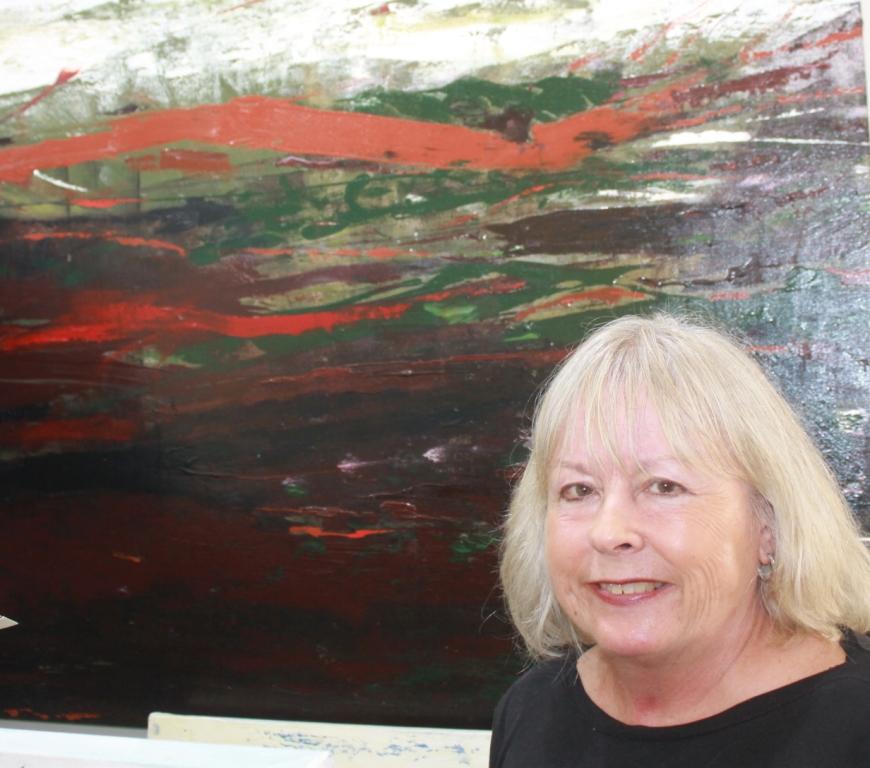
The Edge
Art is a difficult discipline to be lucrative in – has it been so for you?
You only get out of something what you put in. It is necessary to be, constantly, pushing the limits to be noticed. The art world has been difficult since 2008 with many art galleries closing down.
Why do you do paint?
Because of my fascination with the medium and my curiosity of ‘what will happen if I do this?’ After this there is my desire to be famous before I’m dead – so this may be a long haul but I will have achieved something if I’m known as a top Artist. Male Artists may not have a long road, many fade early whereas women Artists seem to have a much longer road – Elizabeth Cummins, she’s 80 and still doing great, beautiful work. Women Artists seem to have a longer story to tell and I’d like to be one of these.
Where did you start from; how did you choose Abstracts?
After developing my basic skills and focussing on patterns in nature in leaves, tree branches, creeks, waves it became a natural transition to see shapes rather than reality, this then became a natural transition to abstract, which is how I see the world.
What do you plan to develop in your Art next?
This new series I spoke of earlier. Every few months I seem to have a new series that just starts. I decided to go smaller as these can be made more affordable for everyone, so a metre by a metre or 36inches by 36inches.
This next series has been inspired by our daily swim at Avalon pool, so much fun and so heavenly. While doing this I’m noticing the seaweed, the rocks. I started off thinking the name for this series would be ‘Driftwood’ and is all about the experience of being in Avalon pool – so the shine, the shimmer, the reflections, the feeling of joy that you get when you’re lying there on your back, floating.
I lie there thinking ‘this has got to be the best place in the entire world’. I feel this massive sense of accomplishment that we own it, we pay our rates, we all own Avalon pool, it’s maintained, kept clean for us.
What are your favourite places in Pittwater and why?
Avalon Beach, because of the pool of course and because I fell a sense of ownership and camaraderie with all of the people who love it so much; the surfers, the swimmers. I can see when I go there people just standing there, watching the beach and the water with awe. It changes every day and that too pushes me on as I think ‘maybe I can paint it this way’ or ‘that way’. Walking down to the beach beside Careel creek is easily one of my favourites and a favourite place. This too changes everyday to me; I’m looking at the undergrowth and the bushes and seeing the darks and the lights. I’ve always had boats and so being on Pittwater or going up the Hawkesbury; we used to take the children up there at Christmas and Easter and sit there for days with a few boats, all of us rafted up together, the children trowing around in little dinghies – great fun.
What is your motto for life or a favourite phrase you try to live by?
Go for it.
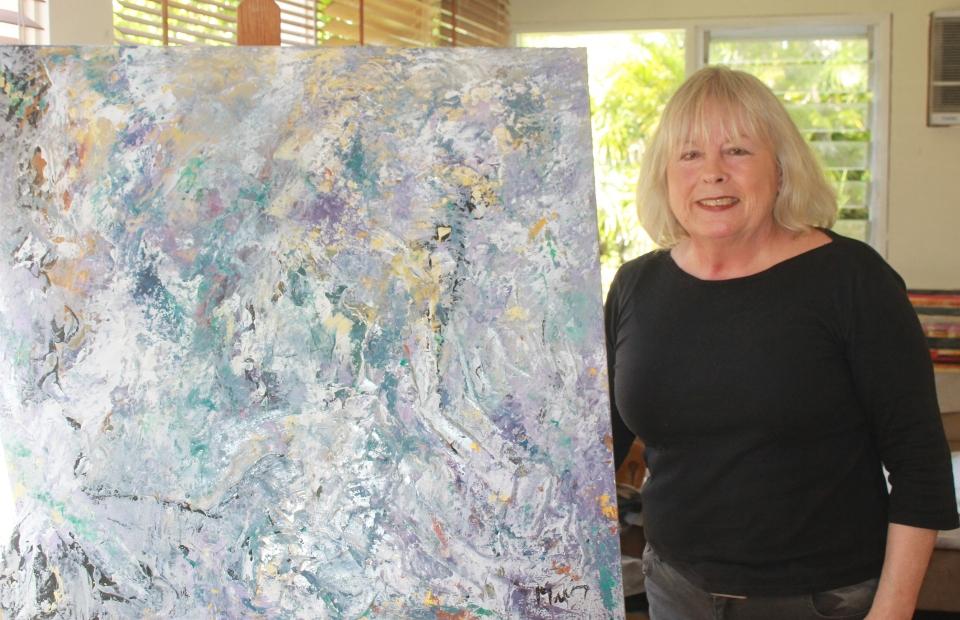
Exhibitions
2004 Group Exhibition at Mosman Artists Colony2004 Archibald Entry - Murray Waldren, Columnist, The Australian
2005 Single Exhibition at Dale Thomas Gallery 2005 Archibald Entry - Bronwyn Bishop, Local MP
2005 Hung in Portia Geech, Women's Portrait Prize 2005 Antipodes Gallery, Connecticut, USA
2006 Archibald Entry - Self Portrait
2006 Single Exhibition, Wentworth Gallery 2006 Art 06 Fox Studios, Sydney
2007 Single Exhibition, Moree Gallery
2007 Macintosh Mercedes Exhibition
2007 Showing Gallery 2, Edward Street Brisbane 2008 Abbotsleigh Centenary Exhibition NSW
2008 Show at Mooch Inside Kilcare NSW
2009 Showing at Aarwun Gallery, Canberra
2010 Showing at Emmas Cottage, Hunter Valley
2010 Joint show Volunteer Marine Rescue NSW Broken Bay
2011 Newport Artworks — Single Exhibition 2011 Avalon Community Centre — Single Exhibition
2012 Avalon Community Centre — Single Exhibition
2014 Parliament House Joint Exhibition
2015 Chosen for Clyde & Co Art Project
www.lizmuir.com.au
EUR is a residential and business district in Rome, Italy, located south of the city centre. The area was originally chosen in 1930s as the site for the 1942 world's fair which Benito Mussolini planned to open to celebrate twenty years of Fascism, the letters EUR standing forEsposizione Universale Roma. The project was originally called E42 after the year in which the exhibition was planned to be held. EUR was also designed to direct the expansion of the city towards the south-west and the sea, and to be a new city centre for Rome. The planned exhibition never took place due to World War II.
The general commissioner of the agency, Vittorio Cini, presented a list of the most prominent Italian architects available to Mussolini. The list included Adalberto Libera, Enrico Del Debbio, Giuseppe Terragni, Giovanni Michelucci, Eugenio Montuori and Giovanni Muzio. Among the large list, Marcello Piacentini (head of the project), Giuseppe Pagano Pogatschnig, Luigi Piccinato, Luigi Vietti and Ettore Rossi were chosen. The first project, on an area of 4 km2 (1.5 sq mi), was presented in 1938.
During the war the uncompleted EUR development suffered severe damage. However, the Roman authorities decided that EUR could be the basis of an out-of-town business district, which other capitals did not begin planning until decades later (for example, London Docklands and La Défense in Paris). Therefore, during the 1950s and 1960s the unfinished Fascist-era buildings were completed and other new buildings were built in contemporary styles for use as offices and government buildings, set in large gardens and parks.
EUR was almost fully completed for the 1960 Olympics, held in Rome. At that time, most of the important infrastructures, such as the Palazzo dello Sport (designed by Nervi and Piacentini) and the Velodromo were completed.
The design was inspired, according to the fascist ideology, to Roman Imperial town planning,[5] with modern elements which came from Italian rationalism, the result being a sort of simplified neoclassicism.
The project develops over orthogonal axes and large and stately buildings, built mainly of limestone, tuff and marble, traditional materials associated with Roman Empire architecture.
The most representative building at EUR, and the symbol of this architectural style, is the Palazzo della Civiltà Italiana (1938–1943), an iconic project which has since become known as the "Colosseo Quadrato" (Square Colosseum). The building was designed by Giovanni Guerrini, Ernesto Lapadula and Mario Romano, and also inspired by Metaphysical art.
EUR, Rome. (2016, February 29). In Wikipedia, The Free Encyclopedia. Retrieved from https://en.wikipedia.org/w/index.php?title=EUR,_Rome&oldid=707577297
The Palace of the Italian Civilization, sometimes also called the Civilization of Labor, is a monumental building which is located in Rome in the modern district of EUR . Designed since 1936 and in 1937, its construction began in July 1938 and it was inaugurated, although incomplete, in 1940; work was interrupted in 1943 only to be completed in the postwar period .
The building is square and looks like a box with four equal sides, with the structure of reinforced concrete and roofing entirely of travertine ; It has 54 per side arches (9-line and in column 6), and for that reason it was also renamed Square Colosseum .
It is declared by the Ministry of Heritage and Culture building of cultural interest pursuant to Legislative Decree. 42/2004, and is therefore bound to exhibition and museum purposes; from July 2013 is leased until 2028 to the high fashion group Fendi.
The history of the palace is closely linked to that of EUR . In fact, after assignment to Rome (just the capital of an empire ) of the ' World's Fair of 1942, the Italian Government intended to take the opportunity to celebrate this date as the twenty years of the Fascist regime and to develop, simultaneously, the urbanization of the city along the road leading to the sea.
In December 1936 a the law established the Universal Exposition of Rome, and in January 1937 the first calls and notices of competition for the design of buildings for the dell'istituendo district of the exhibition, which took the name of 'EUR 42' from Esposizione Universale Roma and the year of institution.
In the arches of the ground floor are 28 statues (6 for the facades towards Viale del Lavoro Civilization and the staircase, and 8 in the other two-sided), each of them allegorical virtues of the Italian people: Clockwise starting from the first to the left of the front of avenue of the Civilization of Labour include the allegories of ' heroism , the music , the' craft , the political genius, the social order, the work , the ' agriculture , the philosophy , the trade , l' industry , the ' archeology , l' astronomy , the history , the inventive genius, the ' architecture , law, the primacy of navigation, sculpture, mathematics , the genius of the theater, the chemistry , the press , the medicine , the geography , the physical , the genius of poetry, painting and military genius. At the four corners of the base are many equestrian statues depicting the Dioscuri , by Publius Morbiducci and Alberto Ferns; the pair of monuments on the southeast side looks towards the avenue of the Civilisation of Labour, on the northwestern side out towards the city from the open side of the hill on which stands the building. The whole complex is located, from the point of view toponomastico, in an area called the Concordia Square.
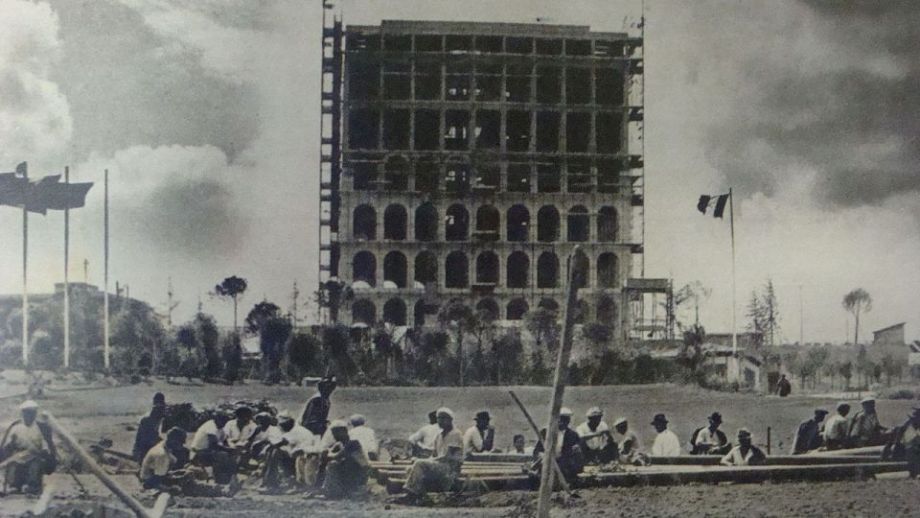
A phase of the construction of the palace in 1940 - Originally Appeared on the cover of the Italian magazine Today in 1940
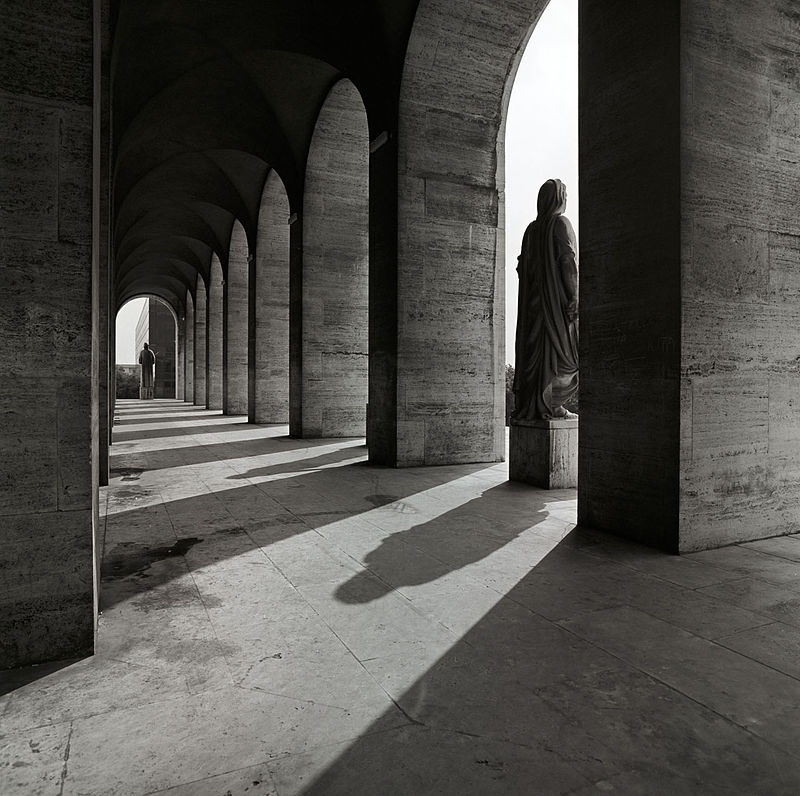
Palace of Italian Civilization side porch 1982 - courtesy indeciso42 - personal library
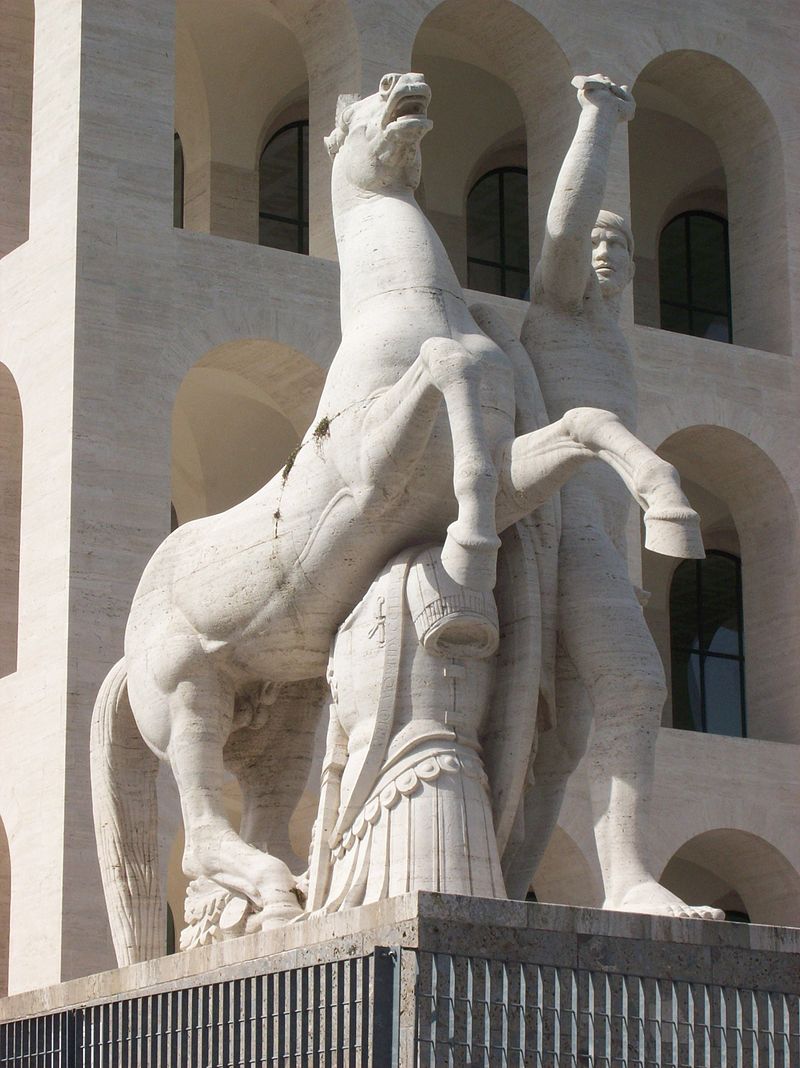
Equestrian monument on the south-western front of the Palace 2011 - courtesy blackcat
Palace of Italian Civilization. (16 March 2016). Wikipedia, The Free Encyclopedia . Retrieved from //it.wikipedia.org/w/index.php?title=Palazzo_della_Civilt%C3%A0_Italiana&oldid=79576475.
